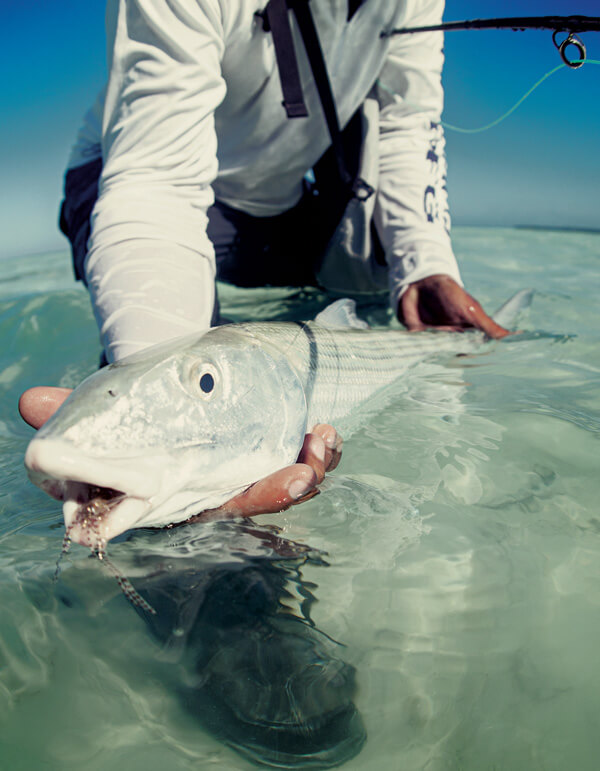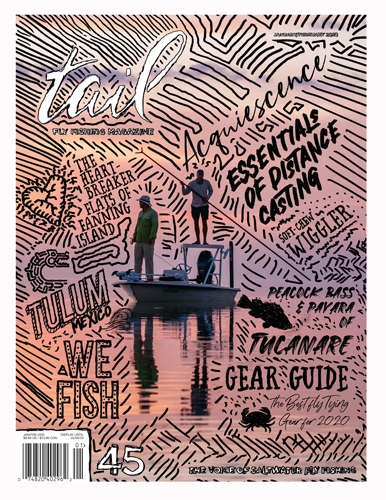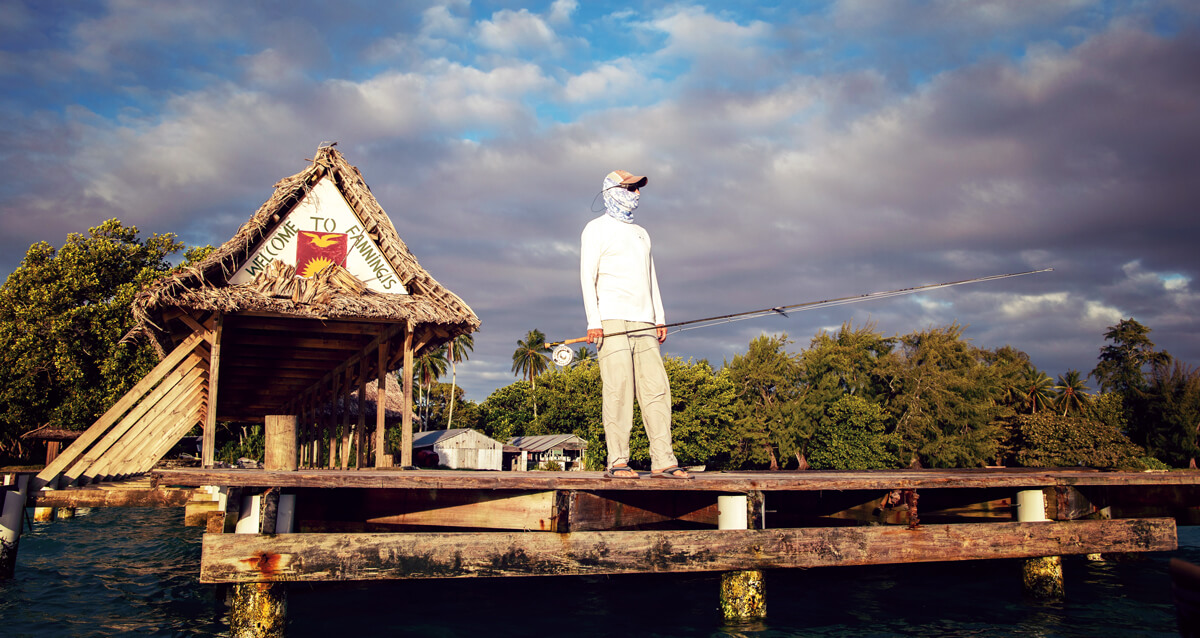It took three days heading west and crossing the Pacific to get here, but after a week we had settled into our routine. We were the only four anglers visiting Fanning Atoll or, as the locals call it, Tabuaeran. With no electrical grid, no cell phones or internet, it was easy to fall into the romance of quaint village life. Rather than an alarm clock, the grunting of neighborhood pigs and the barking of dogs announced that it was time for us to rise each morning.
The Legend of Heartbreak Flat
by Joe Brennan
We were now midway through our second week. Our morning routine unfolded as it did most days: shuffling of feet, stirring of instant coffee, and checking to see if there were any scorpions in the outhouse.
The night before, Mwatanga, head guide at Fanning Island Outfitters, informed us we would be heading northeast from the lodge to Rapa Passage in order to catch the start of the flood tide. It was only a stone’s throw from the lodge to the home-built deep-V wooden skiff. Mounting the gunnel, we joked about being castaways from the S.S. Minnow: It had been more than 50 years since Fanning Atoll served as the backdrop for the opening credits of the TV show Gilligan’s Island.
Tabuaeran’s land mass is about 13 square miles with an inner lagoon of 42 square miles. We thought we had seen every fishable flat when Mwatanga exclaimed, “We have not fished here!”
I looked up from my wooden plank; to my untrained eyes it was just another flat, one of many we would pass on our daily ventures.
“In fact, we have never fished here,” said Mwatanga, as the sheen of the morning sun unfolded a finger flat spanning northeast to southwest.
Often, certain sections of the lagoon’s inner flats are obscured by wave action, discoloring the water and rendering them unfishable–but not this day.
“Do you want to try this spot?” Mwatanga asked matter-of-factly.
Jerry and I agree with a resounding “Yes!” Today, how many people can say they were the first to fish a particular spot…?
Moments later, Jerry and Abrahaim were off, walking northeast. Matt and I opted for the southwest. Like most flats on the island, this flat was fringed by coral reef. Unlike most flats on the island, this flat’s reef was only on the eastern edge.
 Roughly 50 to 75 yards in width, the flat spanned nearly the entire lagoon, a deep blue pool at either end. On the eastern side, the reef’s inner edge crawled about halfway onto the flat, effectively splitting it in half, leaving reef on one side and silky white sand on the other. As we began our patrol, it quickly became evident that we would have a 50/50 chance that a hooked fish would run in a favorable direction.
Roughly 50 to 75 yards in width, the flat spanned nearly the entire lagoon, a deep blue pool at either end. On the eastern side, the reef’s inner edge crawled about halfway onto the flat, effectively splitting it in half, leaving reef on one side and silky white sand on the other. As we began our patrol, it quickly became evident that we would have a 50/50 chance that a hooked fish would run in a favorable direction.
In the time we had fished the island we had become accustomed to seeing big, healthy fish. The average bonefish on Fanning is 4 to 6 pounds, but Jerry and I had been fortunate to land a number in the 7- to 9-pound range. As we walked the line where reef met sand, it was only minutes before we spotted our first bonefish. This was the fish of every angler’s dreams–a true 10-plus-pound monster. Like most bonefish you see on Fanning, it cruised slowly, deliberately, giving you plenty of time to present the fly. So I took my shot, and with two strips I was connected to my personal best bonefish…. And just like that, the fish opted for the reef. I don’t have to tell you what happen next. The coral was simply too much for my 20-pound tippet.
Reset and retie. Back on the beat, and a mere 30 yards farther down the flat we’re greeted by another double-digit bone. I present my fly and the fish greedily takes and in an instant heads east into the coral. Five seconds later I’ve lost my second personal best bonefish. While we laughed at the first encounter, the look we receive from Mwatanga declares that it’s time to get down to business.
Staying focused, we continue down the line, reef to the east, white silky sand to the west. Sure enough, here comes a third fish. We spot it a little farther out than usual, which will give us more time to get ready.
It’s a single, but something’s off—the speed of the fish, or the movement of its tail…. “I think it’s a reef shark,” I say.
“Wait,” Matt says.
A minute later I’m casting to the largest bonefish I’ve ever seen—maybe 15 pounds. I throw my fly and with barely half a strip it smacks off the sand and into the fish’s mouth.
This is it, my time to be the hero. Visions of celebration and warm beers float before my eyes.
The fish turns west, to silky snag-free sand … runs all of 10 feet before hitting the brakes … turns 180 degrees and runs directly into a patch of fan-leaf coral … sails clean off into the eastern horizon … my fly line limp in the water….
No one utters a word.
Feeling defeated–but not broken–we continue our hike, and within a short time we land two back-to-back bonefish in the 7-pound range. For some reason, these very respectable fish are not scratching the itch.
Suddenly, Matt is frantic. He’s trying to separate my two backup rods. He screams, “G.T.! G.T. 60 feet!”
I scan the horizon and sure enough, here come two packs of G.T. motoring across the flat. We scramble, pushing toward the fish to try to intercept the angle.
Matt frees the rod, hands it to me, and we’re off to the races. Stripping off line as we slosh through the water, I manage to get off an upwind shot … short.
“Recast!”
I pick up the line and muster everything the 12-weight will give me. I present the fly right behind the lead fish’s tail–but right in front of the following fish’s head. I strip line like crazy and the G.T. explodes in pursuit, its head and back pushing water up over its dorsum, its mouth agape. I attempt one more strip and I fumble, leaving the fly motionless in the water–if you didn’t know, a baitfish just doesn’t stop fleeing—and the fish turns off my fly. I’m too slow to take another shot, and just like that another trophy fish is headed east.
“That would have been the biggest G.T. I’ve hooked on the flat,” Mwatanga proclaims solemnly.
With the adrenaline dump, my heart is racing. I know I did my best, but there are many things that have to go right in this game—and very few that can go wrong.
We decide to call it quits and walk back to the boat. Jerry and Abrahaim had beaten us there. In his usual fashion, Jerry asks, “How was it?”
“Heartbreaking,” I utter.
The sun is overhead. I remove my buff to enjoy a Spam sandwich. I share my story with Jerry, who relates a tale of losing two double-digit bones in similar fashion.
And that, my friends, is the legend of Heartbreak Flat–where the big fish roam free.
 From the January 2020 issue
From the January 2020 issue
Subscribe to Tail Fly Fishing Magazine


